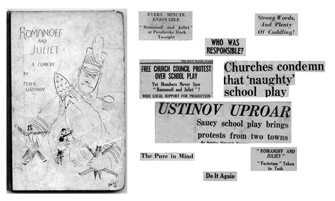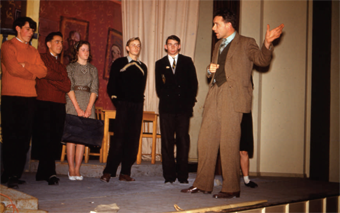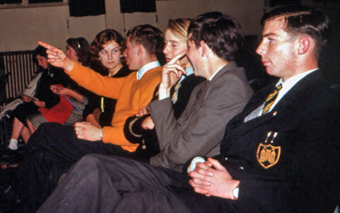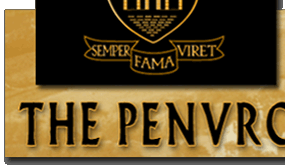|
Memories of Romanoff & Juliet
by Roger MacCallum |
50 years ago in November 1960, the annual school play staged in our school was “Romanoff and Juliet” by Peter Ustinov. It turned out to be the most controversial play ever staged at our school and what follows are some of my recollections of the play itself, newspaper cuttings relating to the subsequent controversy and photographs from the time. I am indebted to Mr Islwyn Griffiths for allowing me to scan the 35mm slides he took in 1960, and to Terry Richards, who took the part of Romanoff in the play, and allowed me to scan the newspaper cuttings he had kept.
|
 |
|
Click on image above to view larger version
|
In the post‐war period in Pembroke Dock and Pembroke Grammar Schools, the annual drama productions had most often been ‘heavyweight’ – plays such as Murder in the Cathedral, Branwen, Coriolanus, The Merry Wives of Windsor etc. Post‐war School Plays had been produced by Miss A.R. Lewis‐Davies and Raymond Garlick, but this task had been taken over by Mr GS Shaw in the early 1950s, one of the first plays he produced being the contemporary play ‘Our Town’ in 1954. He was a true maestro at the art of play production with the ability to take raw teenagers, get the best out of any acting ability they had and put on a series of plays that were a credit to him, the school and the education system in Pembrokeshire. |
 |
|
G S Shaw studiously watches a rehearsal in progress
|
In 1960, Mr Shaw decided that the school should put on another contemporary play. He had seen a production of Romanoff and Juliet by the Arts Council the year before. The auditions were held near the end of the summer term so that those chosen to take part could familiarise themselves with the play over the summer holidays. Mr Shaw was confronted at the audition with a complete mix of people – stalwarts like John Lewis, Charles James, Roger Horgan and Jane Evans from previous plays and new aspiring hopefuls like Peter Lewis, Gwyn Jones, Pat Thomas, Janice Brady and myself. Looking back, I find it hard to believe that in the summer of 1960 I was only 14 and in fact wasn’t 15 until the week the play was staged. The nearest I’d been to a stage was a chapel pulpit, reading the lesson, and I had played the part of the ‘Mad Hatter’ in one of Miss AR Lewis‐Davies English lessons, no doubt to her great displeasure! Much to my surprise Mr Shaw gave me the part of the Spy in the play. In the summer holidays I remember just reading through the play to get familiar with it. It really was a funny play but I remember thinking that the language was perhaps not ‘school play’ material – particularly a soldier suggesting that another soldier was born out of wedlock...
Rehearsals started in earnest in the Autumn Term. GS Shaw had taken it upon himself to
take the part of the General as well as produce the play. I don’t think he did this because he
didn’t believe he had the pupil talent to do it but rather because it was a huge part and
would have taken any pupil a lot of time both to learn and rehearse. After all, there was
rugby to be played, International Club to go to, Monti’s, Brown’s, the ‘22’, and something
else, oh yes, studying!
Mr Shaw went through the play with us giving stage directions and
cutting a few pieces out – including, to great disappointment, the line where Soldier Peter
Lewis was to call Soldier Alan Bowen a bastard. But I distinctly remember when it came to
Peter Lewis questioning the whereabouts of his “bloody rifle” Mr Shaw somewhat wistfully
commenting that we’d leave that in – “I think we’ll get away with that” he said. Subsequent
events were to show that we didn’t get away with it with everyone! |
| Continue next column top right... |
|
Continued from column bottom left |
My memories of rehearsals were that they were such fun! On numerous occasions we would get the giggles, a terrible thing, and rehearsal would come to a stop – “come along, settle down” Mr Shaw would say. But it really was a funny play and we couldn’t help it. Gwyn Jones was a terrible boy for setting people off giggling – well, it was alright for him, playing the part of a guy in hot pursuit of the American Ambassador’s lovely daughter – played by Jane Evans, Gwyn didn’t have to act, just be his normal self but with an American accent. |
 |
Rehearsal in progress whilst the set takes shape in the background. L‐R: Peter Lewis (Soldier) Terry Richards (Romanoff) Jane Evans (Juliet) G S Shaw (The General) Alan Bowen (Soldier) |
 |
Serious stuff: Instructions from the maestro Producer G S Shaw.(Extreme Right) L—R: Alan Bowen (Soldier) Terry Richards (Romanoff) Janice Brady (Marfa) Roger MacCallum (Spy) John Lewis (Vadim) |
The play was set in “the smallest country in Europe” and the action centred around the Town Square with its Church and ancient clock, with, on either side of the square, the Russian and American Embassies. The plot was based on a love affair between the daughter of the American Ambassador and the son of the Russian Ambassador, to the consternation of both sets of parents. The plot thickened on the arrival of an American fridge salesman and the female captain of a Russian warship to whom the daughter and son of the ambassadors were respectively betrothed. Mayhem ensues with the General playing the part of matchmaker, diplomat and narrator. |
 |
Some members of the cast watch others rehearse. L—R: Janice Brady (Marfa) Marilyn Sanders (Beulah) Roger Horgan (Hooper) Roger MacCallum (Spy) Gwyn Jones (Freddie) John Lewis (Vadim) |
 |
|
K A Cooper works on the set & willing helpers paint the scenery
|
| The set, designed by Ken Cooper, the school’s Art Teacher, was a masterpiece of innovation.
In the centre, the town clock with revolving figures who struck the time, which was usually
wrong. The Embassies on either side had both upstairs and downstairs. The upstairs bedrooms
were at table height and had front walls. These ‘walls’ were in fact sheets of muslin
with paintings of Khrushchev and Lincoln on their respective sides. When the action was downstairs the muslin was lit from the front and the walls looked solid. When the action
was upstairs the muslin was backlit and you could see straight through it. It was an amazingly
effective piece of set design and obviated the need for massive set changing between
acts. Unfortunately, photographs fail to illustrate how effective this was. |
Click to continue Romanoff & Juliet
|
|
| Back To Memories Home
|
|
|
|
© 2009-2011 ThePenvro.com - General Copyright Notice: Unless indicated to the contrary, all materials on this site including design, text, graphics, photographs and images are the copyright of ThePenvro.com and are not available for commercial use. All other images and/or photographs appearing on this site are the property of their respective owners, as indicated.
Where copyright for photographs on this site is known, it is indicated. There are other examples where attempts to locate the copyright holders have failed. Wherever the original photographer or company is known they are attributed. However, in some cases, there is no indication of who took the original photo or where the copyright, if any, may reside. If anyone viewing the site can provide such information, the wishes of the copyright holder will be respected. Please contact:info@thepenvro.com
|













